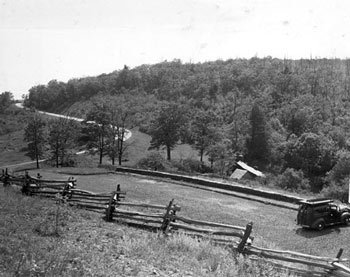In 1876, Martin Brinegar and his wife Caroline purchased land in North Carolina for a farming homestead. They built a cabin, barn, shed, and springhouse, and cleared the sloping land to raise crops and livestock. When the Blue Ridge Parkway was developed, the Brinegar Cabin was restored as interpretive exhibit for visiting motorists. Today's visitors can see the reminders of Appalachian farm life in the nineteenth century, as well as the design typical to the parkway development periods.

NPS
Brinegar Cabin is located at Milepost 238.5 along the Blue Ridge Parkway in North Carolina. The larger Blue Ridge Parkway-Doughton Park landscape is historically significant for the periods of development between 1933 and 1987, and it is potentially a National Historic Landmark. The Brinegar Cabin, a compotent landscape of Doughton Park, is significant on the state level as an Appalachian farmstead and was listed in the National Register in 1972. The landscape provides a view of middle class Appalachian farming and family life from 1885 to 1935, interpreting activities such as loom weaving, traditional subsistence agriculture, regional use of springhouses, and the family cemetery of the Brinegars.
The 2.5 acre roadside interpretive site features four wooden outbuildings clustered in the southeastern corner of the property. The farmstead includes a cabin, granary, springhouse, and a Mission 66 outhouse, as well as a parking lot, an interpretive garden, the location of a former orchard, and several small scale features. All buildings are sided in wooden clapboards and roofed with wooden shingles.

NPS
Before the development of the Blue Ridge Parkway, the Brinegar Cabin was home to Martin and Caroline Brinegar. Built around 1889, the one-and-a-half story log cabin is sheathed in clapboards with two dry stacked chimneys, all resting on a full stone foundation. The Brinegar Cabin preserves important construction techniques commonly used by early settlers in remote regions of North Carolina.

NPS
A picket fence encloses the interpretive garden and flax field west of the Cabin. NPS staff maintains the interpretive garden, which contains (seasonally) buckwheat, flax, sorghum, pole beans, and dipper gourds. An apple orchard to the south of the garden once included 25 to 30 trees, but today is a mown field.
The springhouse is located downslope along the tree line at the south end of the site. The original dry laid stone retaining wall (1942) extends from the northwest corner of the building. The same year, stone steps were added to provide access to the outbuilding. An outhouse for NPS staff was added between the cabin and springhouse in 1957 as part of the Mission 66 initiative.

NPS
Vegetation at Brinegar Cabin consists of a maintained lawn and field enclosed by a white pine and hickory oak hardwood forest to the east and south. The Blue Ridge Parkway is directly north. Catawba rhododendrons were planted along the split rail fence near the granary during the NPS site development, and today White Ash, White Oak, and Black Locust grow around the nineteenth century complex. A cleared vista is maintained from the Brinegar parking lot, overlooking the former orchard and distant mountains.
Brinegar Cabin represents a glimpse into the middle class Appalachian farming/family life from 1885-1935. The landscape also reflects its use as an interpretive site since the period of Parkway development. Craft demonstrations occur during the summer months, and the annual Brinegar Days celebrate the area’s mountain heritage.
Quick Facts
- Cultural Landscape Type: Designed
- National Register Significance Level: National
- National Register Significance Criteria: A, C
- Period of Significance: 1933-1987
Landscape Links
Part of a series of articles titled Cultural Landscapes of Blue Ridge Parkway: Doughton Park.
Last updated: December 31, 2020
